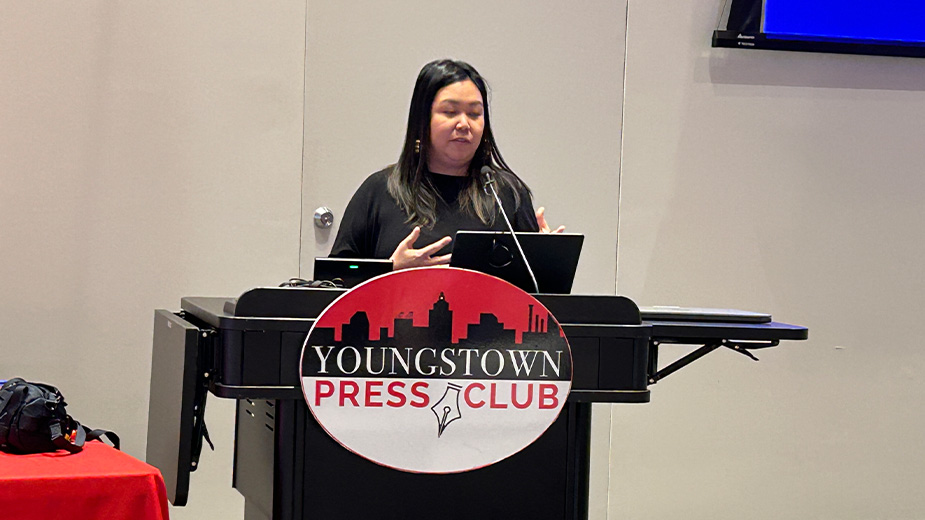Tree Management Takes More than a Big Saw
YOUNGSTOWN, Ohio – Even if it’s not as exciting as the crash of a large tree after the lumberjack’s yell of “Timber!” there’s still a simple beauty in watching a crew trim and cut down backyard trees.
Cutters work around trees, cutting back limbs from all angles as they fold themselves to be in just the right spot. Ground workers clean up brush and secure any large branches to prevent them from doing any major damage, to person or property. Everyone’s moves are working in unison with the rest of the crew’s.
“If you watch a tree go down, it’s like a ballet in the sky. It looks like he’s just making cuts, but everything’s calculated,” says Daniel Smallwood, owner of Smallwood’s Tree Service in Hubbard. “Before I make a cut I make three or four scenarios in my head. When in doubt, we rope it out. We put control lines on it so we know where it’s going to go.”
Those cuts are the climax of hours of work on a job site and years of experience beforehand. Cutters aren’t just considering the best way to trim back branches, they’re thinking about where they will fall, what’s beneath them, the limits of their machinery and minding their own safety as well.
“Safety training, climbing, running the bucket truck: You know where the limb’s going to go, but you’ve got to set the machines up so you aren’t banging the limbs of the tree off the lift,” says Matt Baird, owner of Baird’s Tree Service, Canfield. “With a crane, you have to know what you can and can’t reach. You’ve got to know the limitations on everything.”
According to the Tree Care Industry Association, the injury rate in tree service jobs was more than double the all-industry average in 2016, with an average of 2.4 injuries that caused workers to miss time per 100 full-time equivalent employees. That same year, the all-industry rate was 1.1 injuries. And in 2017, the association reported 72 work-related deaths. Of the 129 injury incidents recorded by the Tree Care Industry Association that year, most were caused by falling limbs, 43 incidents, and worker falls, 22 incidents.
While there are industry groups that provide training and credentials, the Occupational Safety and Health Administration has no formal rules on safety training or regulations for tree services. In the spring of 2017, the federal agency designated the development of standards for the tree-care industry as a “long-term action.”
With no official guidance, businesses have taken their own precautions in instilling good safety habits in workers. It’s not uncommon for new hires to shadow at job sites as they learn the ropes, while safety meetings are held frequently.
“Their first day, we have them be paid bystanders. They might get some hands-on things but they’re mostly there to learn,” says Charles Sawtelle, owner of Sawtelle Tree Service in Vienna. “We’ll pull them aside a few times a day as a learning opportunity; ‘I did this because of this,’ or ‘Don’t ever do this.’ ”
When work is rained out, he adds, the company holds staff meetings to review worksite safety.
“We all need jobs to make ends meet but we all have families to go home to,” Sawtelle says. “We have all the safety gear: leg chaps to protect against chainsaw cuts, helmets with intercom systems, gloves, safety glasses and training on the equipment.”
There’s also the general public to worry about, adds Geoff Clark, manager of the Davey Tree Expert Co. Youngstown office.
“One of the biggest things we have is traffic. Sometimes trucks are set up off the side of the road. Cones are set up and so are signs,” he says. “We’ll go so far, if we have to, as to shut a lane down and set up flaggers. We’re dealing with the public in motor vehicles and pedestrians walking underneath where we’re working.”
And beyond worker safety, there’s also the safety of trees to consider as well. Over the years, the Mahoning Valley has been hit by bouts of emerald ash borer and dutch elm diseases which have decimated the species they affect. Most recently, oak wilt has started to creep into the region.
To recognize such diseases – and to learn how to prune trees properly without damaging them – many firms employ arborists, certified by either the National Arborist Association or International Society of Arboriculture. Sawtelle is in the process of earning his certification while David Colley, owner of Bazetta Tree in Bazetta, has held his since the early 1990s.
“It may be a one in a thousand chance, but if you don’t know about it and trim someone’s 100-year-old oak tree and it gets oak wilt and dies, they’re not going to be happy,” Colley says.
Adds Sawtelle, “I educate my crew and everyone on my crew can identify at least 75% of the trees in our area. We know the ins and outs of each species and what to look for.”

Likewise, Clark holds an International Society of Arboriculture certification, which requires 10 credits of continuing education per year.
“The issue is that a lot of people aren’t familiar with it. So it’s an education process to get them up to speed as to what the effects of that disease is on their trees,” he says. “The problem is that by the time we can see the oak wilt disease, treatment isn’t going to work. I’d say that maybe 15% of what we’re doing is preventative, maybe less.”
It’s that sort of expertise and equipment that drives much of the cost of having work done, the tree-service owners agree. A wood chipper can cost $8,000, a lift $30,000 and a Bobcat another $60,000. Having half a million dollars worth of equipment on a job site isn’t unheard of, Baird says. Add in the half dozen or so workers that need to be paid, and things can add up, he says.
“They don’t see the insurance, the workers’ comp. It’s one of the most dangerous jobs in the country and insurance and workers’ comp reflects that,” he says.
While equipment can be paid off and repaired in-house, the costs of workers are continual, says Bazetta Tree’s Colley. The cost of insurance and workers’ compensation has at times equalled what he’s paying in wages, he says.
“If you have liability – we have $2 million – and workers’ comp, you’re showing a level of professionalism over guys that don’t,” he says. “The labor, especially with climbers, isn’t cheap. If you have experienced guys and you want to keep them, you’ve got to pay the going rate. … That’s probably the biggest single expense.”
There is no standard for pricing in the industry, Smallwood says. Coming up with an estimate requires an on-site inspection and the consideration of logistics.
When someone calls and asks for an estimate over the phone, even if they describe what kind of work they want done, he jokingly tells them it’ll cost $1 million because there’s no way to know the cost of a job without knowing the site, the trees and what other jobs are nearby.
“If you ask me, you’ll get an answer. If you call someone else, you’ll get another answer. I think of it like visiting a mechanic, when one says replacing a part is $300 and the other says $900. It’s the same part, but they have different costs,” he says. “We do multiple stops that are all less than $200, maybe eight or 10. We try to get customers to understand that we have the price, but you’ll have to wait until there’s something else in their area.”
For basic trimming work, he explains, a job may be $225 if there are no other stops nearby. That price can fall to around $100 if enough customers are close together. Most people, he says, are willing to wait a couple weeks for the schedule to get filled in.
At Baird’s Tree Service, jobs can range from $800 to nearly $4,000, the owner says.
For Bazetta Tree, a day-long takedown of a tree can run above $1,000, Colley says.
With so many variables affecting price and so many companies offering tree services – from nationwide companies such as Davey to people doing it as a side gig on weekends, as Sawtelle did before starting his business in 2008 – competition is fierce.
But, it’s also lucrative.
Last year, Smallwood’s Tree Service eliminated the landscaping aspect of its business, the sector it was initially focused on before customers started requesting that trees be trimmed back.
Asked why he made the move, Smallwood had a simple answer: “Way more profitable.”
Pictured:Kain Marshall with Bazetta Tree thinks about what happens after he cuts a limb: how it will fall and what’s underneath.
Copyright 2024 The Business Journal, Youngstown, Ohio.



